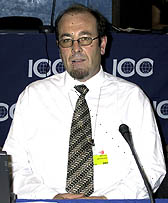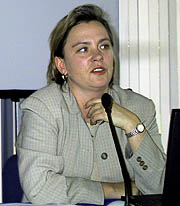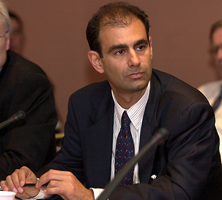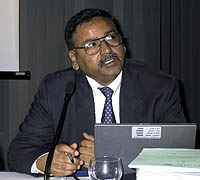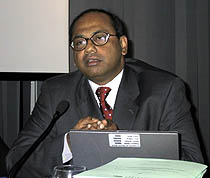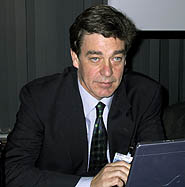|
|
|||||||||||||||||||||||||||||||||||||||||
|
|||||||||||||||||||||||||||||||||||||||||
|
Events convened on Thursday, 8 November 2001 |
|
Suppressed energy demand projects in the CDM Presented by GLOBE Europe in collaboration with GLOBE Southern Africa and SouthSouthNorth
Thorne noted that the market for CDM projects tends to follow foreign direct investment and therefore benefits only a small number of more developed developing countries. Allowing the inclusion of suppressed demand in baselines would serve to level the playing field and provide an advantage to underserviced areas, therefore enabling a wider range of countries, particularly least developed countries (LDCs), to attract CDM projects. As a result, CDM projects could better contribute to sustainable development. He noted difficulties with quantifying suppressed demand and incorporating it into the baseline, including determining how far into the future the baseline should be set and at what level an energy service is considered fulfilled. Axel Michaelowa, Hamburg Institute of International Economics, outlined the social implications of accepting suppressed demand in CDM baselines. He stated that with low certified emissions reductions (CER) prices, investors will only be interested in larger CDM projects with low transaction costs, typically in countries with more efficient institutions and infrastructure in place. He explained that suppressed demand projects create direct social benefits by generating income that allows poorer groups to purchase goods and services, such as consumption goods, grid-connected energy, and transportation services. Michaelowa
outlined three types of suppressed demand projects, including
those that provide energy services, such as renewable energy,
low-carbon fuels or efficient transmission; consumption goods,
such as efficient appliances, low-emission waste management or
efficient production processes; and transport, such as efficient
vehicles or infrastructure. He highlighted the social benefits
of these types of projects, and emphasized that small-scale projects
can be better targeted to benefit lower income groups and tend
to generate co-benefits locally.
|
|
The carbon market: Status and future prospects Presented by the Union of Industrial and Employers' Confederations of Europe (UNICE)
Boone said
the simulation revealed that: trading activity was highest in
the second round of trading; emission allowance allocations were
the most traded instrument due to low associated risk; cost curves
varied significantly for different sectors; compliance shortfall
was highest for the oil and gas sector; the electric utility and
oil and gas sectors were net buyers; and the cement and chemical
sectors were net sellers. She concluded that the simulation demonstrated
how directly policy decisions impact market behavior.
Atle Christiansen
and Kristian Tangen, PointCarbon, examined factors influencing
the estimation of carbon price. They stated that the price of
carbon will largely depend on whether the US re-enters the Kyoto
Protocol process, which is unlikely to occur in time for the first
commitment period. Additional factors affecting the price of carbon
include the amount of carbon to be banked, the extent of banking,
the impact of the second commitment period, and price manipulation
by cartels or dominant sellers. Christiansen and Tangen concluded
that carbon prices would only collapse in the unlikely events
that: Russia and the Ukraine did not meet the eligibility requirements
for carbon trading; there were no second commitment period; or
prices were manipulated. In the absence of these factors, the
price per tonne of CO2 equivalent would approach US$11.
|
|
Sweden's climate policy, Local Investment Programmes, and greenhouse gas reduction Presented by the Swedish delegation
Olle Oskarsson, Swedish Ministry of the Environment, described the Swedish Government's Local Investment Programmes, an initiative that provides funding for local-level sustainable development projects. The programme's objectives are to prioritize ecological sustainability at the local level, increase public awareness, support implementation of Agenda 21 plans, stimulate cooperation between participants, and generate employment. Kristina Feldhusen, Swedish Ministry of the Environment, noted that climate change projects undertaken through the Local Investment Programmes include transportation and energy projects. She emphasized that sustainable development requires not only technological solutions, but also a change in thinking and planning. Hanna Roberts, Western Harbour Housing Project, described a housing district located in Malmö, Sweden, which promotes ecological sustainability by, inter alia, meeting 100 percent of its energy needs through locally produced wind and solar energy. She highlighted the Project's "Quality Programme," which focuses on reducing energy consumption in the housing district through, inter alia, the installation of energy efficient appliances and lighting. Sarah Nilsson, City of Växjö, outlined the "Fossil Fuel Free Växjö" programme. She highlighted that Växjö achieved emissions reductions of 18 percent below 1993 levels by 1999, largely through the substitution of biomass for oil in district heating, and aims to reduce emissions by 50 percent by 2010.
|
|
Worldwide gas flaring reduction initiative Presented by the Norwegian delegation in collaboration with the World Bank
Rashad Kaldany, International Finance Corporation (IFC), described the causes of gas flaring, including inadequate contractual arrangements in the petroleum industry, lack of gas markets, inefficient gas use, and lack of economic incentives for gas flaring reduction. He noted that the impacts of gas flaring on climate change are poorly understood. Kaldany explained that the joint Norwegian-World Bank initiative will: convene consultations and conferences; improve and disseminate knowledge; introduce improved contractual and regulatory frameworks; and devise best regulatory practices. It aims to design financing mechanisms to reduce gas flaring and identify pilot projects for flaring reduction in developing countries and economies in transition. The initiative's challenges include the need to find additional investment and financing, provide fuel choice flexibility, and consider the social impacts of energy price reforms. Discussion: Participants highlighted the difficulty of reducing gas flaring in light of high oil prices, and discussed novel mechanisms for reducing flare and saving gas. One participant noted that oil companies should only be allowed to open new oil fields when they adequately address the issue of gas flare reduction.
|
|
Come hell or highwater: Mainstreaming adaptation in World Bank operations Presented by the World Bank
Wayne King, representing Pacific Island States, described the GEF-funded Pacific Islands Climate Change Assistance Programme, which developed national implementation strategies and policies for vulnerability and adaptation by sector. He highlighted a Regional Framework for Action on Climate, supported by a programmatic approach, which guides policy and aims to coordinate various climate-related initiatives and collaboration among all stakeholders. Rawleston Moore, Caribbean Planning for Adaptation to Climate Change (CPACC), outlined the impacts of climate change on the Caribbean, including decreased rainfall, coral bleaching, increased tropical storms, sea-level rise, and impacts on agriculture and coastal zone development. He highlighted CPACC's achievements, including: establishing a sea-level and climate monitoring system; establishing coral reef monitoring protocols; conducting initial coastal vulnerability assessments; building capacity; developing a coastal resources information system; and compiling initial adaptation policies. Alan Miller,
GEF, described GEF financing for adaptation. He explained that
GEF support was initially limited to support of Stage I activities
(vulnerability assessments) in the context of national communications,
but is now entering a crucial period of changing guidance, which
could result in GEF support for reviews of climate change impacts
and potential adaptation. He noted that 40 percent of GEF funding,
over US$1 billion, has gone to climate change projects, mostly
for GHG mitigation.
|
|
Reducing vulnerability and strengthening adaptive capacity: Strategies for integrating UNFCCC and UNCCD interventions Presented by UNDP
Richard Klein, Potsdam Institute for Climate Impact Research, outlined the results of a recent workshop on "Enhancing the Capacity of Developing Countries to Adapt to Climate Change." The workshop's objectives were to establish an effective and cross-cutting dialogue between relevant actors involved in adaptation to climate change in developing countries, and to develop an agenda for research on how to enhance developing countries' capacity to adapt to climate change. He noted that participants from donor countries highlighted adaptation to climate change in developing countries as a priority for bilateral and multilateral assistance, whereas participants from developing countries said that adaptation to climate change is not a priority due to more immediate concerns such as water and food scarcity, education and public health. Philip Dobie, UNDP Drylands Development Centre, noted that drylands peoples are capable and adaptable, but they are marginalized geographically and politically, are dependent on the exploitation of natural resources, and are vulnerable to desertification and impacts of climate change. He highlighted the need to integrate drylands policies into mainstream policy, build adaptation and vulnerability into macroeconomic policy, and strengthen governance and institutions, particularly at the local level. He concluded that national action plans prepared by countries affected by desertification could be used as the basis for adaptation plans. John Virdin, World Resources Institute, noted that drylands communities have practiced adaptation measures for centuries, but due to their increasing vulnerability to desertification and climate change, there is increasing urgency for policies and measures that enable win-win activities to both combat desertification and assist adaptation to climate change. He highlighted the need to coordinate efforts between the UNFCCC and the Convention to Combat Desertification, strengthen institutions for collaborative management with communities, and provide drought mitigation and prevention programmes.
|
|
For
further RealVideo coverage of these and other side-events at COP-7,
please visit the UNFCCC's "On Demand" webcast page |
|
| The Earth Negotiations Bulletin (ENB) on the side is a special publication of the International Institute for Sustainable Development (IISD) in cooperation with the United Nations Framework Convention on Climate Change (UNFCCC) Secretariat. The Editor of ENB on the side is Kira Schmidt <kira@iisd.org>. This issue has been written by Fiona Koza <fiona@iisd.org>, Dagmar Lohan <dagmar@iisd.org>, and Kira Schmidt <kira@iisd.org>. The Digital Editors are Andrei Henry <andrei@iisd.org>, Leila Mead <leila@iisd.org> and Kenneth Tong <ken@iisd.org>. Funding for publication of ENB on the side at COP-7 is provided by the UNFCCC Secretariat. The opinions expressed in ENB on the side are those of the authors and do not necessarily reflect the views of IISD and funders. Excerpts from ENB on the side may be used in non-commercial publications only and only with appropriate academic citation. For permission to use this material in commercial publications, contact the Managing Editor at <kimo@iisd.org>. Electronic versions of these issues of ENB on the side from COP-6 Part II can be found on the Linkages WWW server at http://enb.iisd.org/climate/cop7/enbots/. | |
|
|
| © 2001, IISD. All rights reserved. |
|



